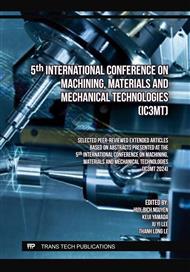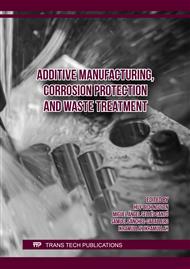p.3
p.13
p.21
p.31
p.39
p.47
p.59
p.65
Drilling Characteristics of Plastic Materials with Adaptive Control of Feed Rate
Abstract:
Adaptive feed-rate controlled (AFC) drilling has been proposed as a high-quality and highly efficient drilling method for thermoplastic resins. The feed rate of the drill tool is controlled by the load in the thrust direction during AFC drilling. In the early stages of AFC drilling, the drill feed rate is extremely low, followed by a sudden increase in the drill feed rate. Experimental investigations revealed that the temperature near the drilling point had a dominant effect on the position at which the drill feed rate transitioned from low to high. The feed-rate transition temperature was approximately 150 °C for PA6. Therefore, the feed-rate transition position accelerated as the spindle speed increased, which significantly affected the cutting temperature. After the feed rate transitioned to a higher speed, drilling progressed at a constant rate. Additionally, the temperature of the drilled hole was generally constant regardless of the hole depth. One of the applications in which AFC drilling is expected to be superior is the drilling of different stacked materials. The effectiveness of AFC drilling was examined and compared with general constant-feed drilling for a stacked material of PA6 and carbon-fiber-reinforced thermoplastics. When the drilling efficiency was aligned, the maximum thrust force during AFC drilling was suppressed to less than 50% of that during general constant-feed drilling. Furthermore, the finished inner surface of the drilled hole was better after AFC drilling.
Info:
Periodical:
Pages:
13-20
Citation:
Online since:
March 2025
Authors:
Keywords:
Price:
Сopyright:
© 2025 Trans Tech Publications Ltd. All Rights Reserved
Share:
Citation:



